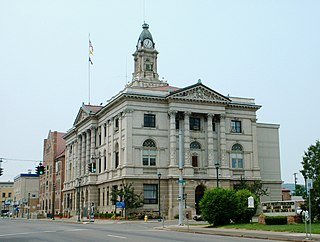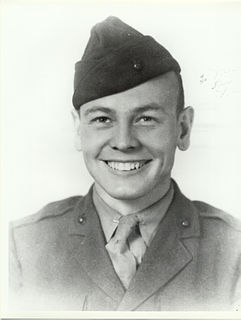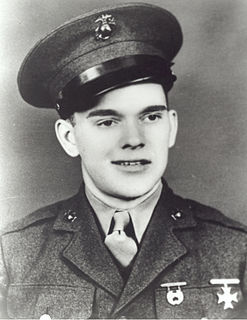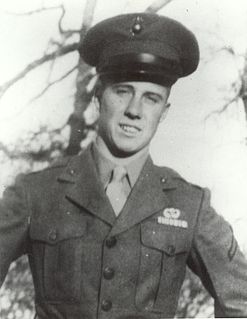Private John Joseph Wantuck (23 November 1923 – 18 July 1943) was a United States Marine and posthumous recipient of the Navy Cross for his actions on New Georgia in July 1943
A private is a soldier of the lowest military rank.

The United States Marine Corps (USMC), also referred to as the United States Marines or U.S. Marines, is a branch of the United States Armed Forces responsible for conducting expeditionary and amphibious operations with the United States Navy as well as the Army and Air Force. The U.S. Marine Corps is one of the four armed service branches in the U.S. Department of Defense (DoD) and one of the seven uniformed services of the United States.

New Georgia, with an area of 2,037 km2, is the largest of the islands in Western Province, Solomon Islands, and the 200th-largest island in the world.
Wantuck was born on 23 November 1923 in Elmira, New York. He enlisted in the United States Marine Corps on 6 January 1942. After basic training at the Marine barracks at Parris Island, South Carolina, he served at Guantanamo Bay, Cuba, from 30 June 1942 until late in 1942.

Elmira is a city in Chemung County, New York, United States. It is the principal city of the Elmira, New York, metropolitan statistical area, which encompasses Chemung County, New York. The population was 29,200 at the 2010 census. It is the county seat of Chemung County.

New York is a state in the Northeastern United States. New York was one of the original thirteen colonies that formed the United States. With an estimated 19.54 million residents in 2018, it is the fourth most populous state. To distinguish the state from the city with the same name, it is sometimes called New York State.

Marine Corps Recruit Depot Parris Island is an 8,095-acre (32.76 km2) military installation located within Port Royal, South Carolina, approximately 5 miles (8.0 km) south of Beaufort, the community that is typically associated with the installation. MCRD Parris Island is used for the training of enlisted Marines. Male recruits living east of the Mississippi River and female recruits from all over the United States report here to receive their initial training. Male recruits living west of the Mississippi River receive their training at Marine Corps Recruit Depot San Diego, California, but may train at Marine Corps Recruit Depot Parris Island by special request.
By 5 December 1942, Private Wantuck was serving in the Solomon Islands where, on 30 June 1943, he went ashore with other Marines at Zanana beach on the island of New Georgia. For two weeks, the troops tried to dislodge the Japanese defenders farther inland near Munda while Wantuck served with the beachhead and supply depot antiaircraft defense unit.

Solomon Islands is a sovereign state consisting of six major islands and over 900 smaller islands in Oceania lying to the east of Papua New Guinea and northwest of Vanuatu and covering a land area of 28,400 square kilometres (11,000 sq mi). The country's capital, Honiara, is located on the island of Guadalcanal. The country takes its name from the Solomon Islands archipelago, which is a collection of Melanesian islands that also includes the North Solomon Islands, but excludes outlying islands, such as Rennell and Bellona, and the Santa Cruz Islands.

Japan is an island country in East Asia. Located in the Pacific Ocean, it lies off the eastern coast of the Asian continent and stretches from the Sea of Okhotsk in the north to the East China Sea and the Philippine Sea in the south.

Munda is the largest settlement on the island of New Georgia in the Western Province of Solomon Islands, and consists of a number of villages. It is located at the southwestern tip of the western end of New Georgia, and the large Roviana Lagoon is just offshore.
On 17 July 1943, the Japanese mounted a major offensive at the severed and disoriented American forces. Though eventually stymied in their attempt, they managed to reach the perimeter of the beachhead and Private Wantuck's position. Using a light machine gun salvaged from the discard pile, Wantuck stuck to his position through the night. The following morning, after the Japanese offensive had been repulsed, Private Wantuck was found dead at his machine gun with evidence in front of him that he had killed 18 to 20 Japanese and had probably wounded many more.

A machine gun is a fully automatic mounted or portable firearm designed to fire rifle cartridges in rapid succession from an ammunition belt or magazine for the purpose of suppressive fire. Not all fully automatic firearms are machine guns. Submachine guns, rifles, assault rifles, battle rifles, shotguns, pistols or cannons may be capable of fully automatic fire, but are not designed for sustained fire. As a class of military rapid-fire guns, machine guns are fully automatic weapons designed to be used as support weapons and generally used when attached to a mount- or fired from the ground on a bipod or tripod. Many machine guns also use belt feeding and open bolt operation, features not normally found on rifles.
For his gallant defense and supreme sacrifice Private Wantuck was awarded the Navy Cross posthumously.
The United States Navy high-speed transport USS Wantuck (APD-125), in commission from 1944 to 1957, was named for him.

The United States Navy (USN) is the naval warfare service branch of the United States Armed Forces and one of the seven uniformed services of the United States. It is the largest and most capable navy in the world and it has been estimated that in terms of tonnage of its active battle fleet alone, it is larger than the next 13 navies combined, which includes 11 U.S. allies or partner nations. with the highest combined battle fleet tonnage and the world's largest aircraft carrier fleet, with eleven in service, and two new carriers under construction. With 319,421 personnel on active duty and 99,616 in the Ready Reserve, the Navy is the third largest of the service branches. It has 282 deployable combat vessels and more than 3,700 operational aircraft as of March 2018, making it the second-largest air force in the world, after the United States Air Force.

USS Wantuck (APD-125) was a United States Navy high-speed transport in commission from 1944 to 1957.








